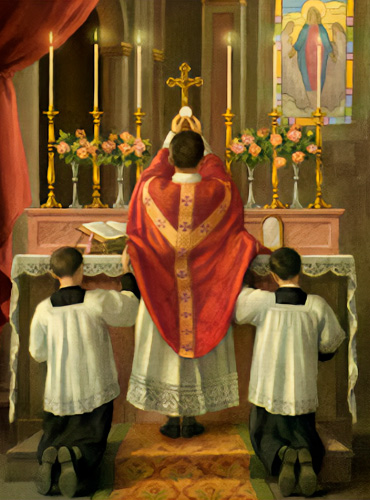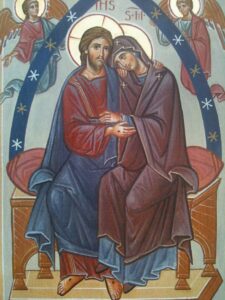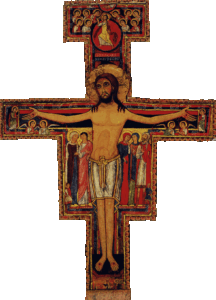The Holy Mass is a miracle of prolongation. Christ’s priesthood and His sacrifice are prolonged in a sacramental manner in the Mass.
A. The Perpetuation of Christ’s Priesthood
Christ’s priesthood is continued not only in the Mass, but also in every liturgy, which is “an exercise of the priestly office of Jesus Christ.”[1] Thus, when a priest baptizes, confirms, celebrates the Eucharist, confesses, anoints the sick, ordains, or marries,[2] it is Christ who baptizes, confirms, celebrates the Eucharist, confesses, anoints the sick, ordains, or marries.[3] Christ carries out the acts of His eternal priesthood by means of His priests, both ministerial and common (by virtue of baptism).
Jesus Christ is the principal priest of the Holy Mass because He offers each and every one of the Masses that is celebrated. The same act of internal oblation of the Victim of the sacrifice of the cross is perpetuated in the internal act of oblation of the Victim of each sacrifice of the Mass. This is done by means of the powers that Christ transmits through the sacrament of Holy Orders. In this way, the sacramental priest, as a sensible and effective sign of Christ, the invisible Head, offers the sacrifice of the Body and Blood of the Lord, likewise in a sensible and effective manner.
In the “ordained minister, it is Christ himself who is present to his Church as Head of his Body, Shepherd of his flock, high priest of the redemptive sacrifice, Teacher of Truth.”[4] The Church teaches this saying that the visible priest, “by virtue of the sacrament of Holy Orders, acts in persona Christi Capitis,”[5] that is, in His name and with His authority. The ministerial priest is the image of Christ the priest, “an ‘icon’ of Christ the priest.”[6] Christ is the first and only priest of the Church, and “all other priests are His sac-ramental images.”[7]
The priest is taken from among men, so that he is able to deal patiently with the ignorant and erring, for he himself is beset by weakness (Heb 5:1-2). The ministerial priest is not immune from weaknesses, limitations, imperfections, or human failings. In short, he is not free from sin. He must repent from his sins, confess them like any other person, offer sacrifice, and do penance. However, the very power of the Holy Spirit guarantees that “even the minister’s sin cannot impede the fruit of grace”[8] in the sacraments.
The ministerial priest proclaims the Word of God, and he presents the gifts of bread and wine to God; later he immolates those very same gifts, and offers them to be transubstantiated into the Lord’s Body and Blood. In all of these priestly functions he works in the name and with the power of Christ Himself, in such a way that only the power of God is above him, as Saint Thomas Aquinas teaches: “The priest’s power does not depend on a higher power save God’s.”[9] Not even the Pope has power greater than a simple priest’s for the consecration of Christ’s Body. “Over the consecration of Christ’s body, the Pope’s power is no greater than that of a simple priest.”[10]
By reason of their baptism, the lay Christian faithful offer the immolated Victim to God in the Holy Mass through the hands of the priest and along with the priest. They offer themselves with the Victim, together with their works, pains, joys, acts of adoration, thanksgiving, requests for forgiveness, petitions, etc.
B. The Perpetuation of Christ’s Sacrifice
Upon ordering His Apostles at the Last Supper, Do this in memory of me (Lk 22:19; 1 Cor 11:24-25), Christ commanded them to repeat the rite of the Eucharistic sacrifice of my body, which will be given up and my blood, which will be shed (Lk 22:19, 1 Cor 11:24-25). The Council of Trent teaches that at the Last Supper, Jesus Christ, upon offering His Body and Blood sacramentally “to His Apos-tles, He commanded them, who He thereby constituted as priests of the New Testament, together with their successors, to celebrate it until His return.”[11]
It is a dogma of the faith that “in the sacrifice of the Mass, we offer God a true and proper sacrifice.”[12]
The Mass is truly a sacrifice for three reasons:
– It re-presents the Sacrifice of the cross.
– It is the memorial of the Sacrifice of the cross.
– It applies the fruit of the Sacrifice of the cross.[13]
Christ left the Church the Eucharistic Sacrifice “by which the bloody sacrifice which he was to accomplish once for all on the cross would be re-presented, its memory perpetuated until the end of the world,[14] and its salutary power be applied to the forgiveness of the sins we daily commit.”[15]
Our Lord wanted His Sacrifice to be perpetuated “because his priesthood was not to end with his death[16] . . . and so to leave to his beloved spouse, the Church, a visible sacrifice (as the nature of man demands), He offered His Body and Blood to God the Father, under the species of bread and wine.”[17] Thus His disciples, who, because they were men, had not only souls but bodies as well, could offer a visible sacrifice to God as their nature required.
The sacrifice of Jesus Christ, made once and for all, is of infinite value and is enough to pardon all the sins of the world. Christ wanted men of all ages to participate in it, and because it is impossible that Christ would die again, for He lives a glorious and im-mortal life, He left us His unique sacrifice, but in a different manner.
He left it in an unbloody, that is, sacramental, way. It is not in its proper species, but rather in a different species. Christ left us His Body that was given up and His Blood that was shed under the species of bread and wine.
The sacrifice of the cross perpetuates itself in the moment of the double consecration of the bread and the wine; in that moment, Christ’s Blood sacramentally appears, separated from His Body, just as happened on the cross. In the consecration, the immolation and the oblation are united. There is, however, a distinction between them, because “a sacrifice, properly speaking, requires that something be done to the thing which is offered to God. . . . On the other hand, an oblation is properly the offering of some-thing to God even if nothing be done thereto. Hence every sacrifice is an oblation, but not conversely.”[18]
“In this divine sacrifice which is celebrated in the Mass, the same Christ who offered himself once[19] in a bloody manner on the altar of the cross is contained and offered in an unbloody manner.”[20]
It is Jesus Christ, the principal priest, who does this, but only by means of the sacramental priest: “It is one and the same victim here offering himself by the ministry of his priests, who then of-fered himself on the Cross; it is only the manner of offering that is different.”[21]
Jesus Christ offers the Mass by means of His visible priest; the lay Christian faithful, by means of and together with the visible priest, offer the Mass to unite their oblation with the oblation of Christ Himself.
In Communion we “truly, really, and substantially”[22] receive the Body and the Blood, together with the Soul and Divinity, of our Lord Jesus Christ.
To consume the victim of a sacrifice is to participate in that sacrifice. This is why Saint Paul asks, Are not those who eat the sacrific-es participants in the altar? (1 Cor 10:18), saying that it is evident that those who eat the victim participate in the sacrifice. To consume the Victim in the Mass is to participate in the Sacrifice of the Cross.
Upon receiving Communion, we receive Christ, Head of the Mystical Body, Head of the Church. The more we unite ourselves to Him, the more we unite ourselves to the members of His Mys-tical Body. Accordingly, the Eucharist makes the Church; it is the sacrament of ecclesial unity: we, though many, are one body, for we all partake of the one loaf (1 Cor 10:17).[23]
May we always hunger more and more for the Eucharist!
May we never abandon the Holy Mass! It is the treasure of the Christian!
A profound mystery is perpetuated there, the mystery in which “life dies on the cross, on a cross crucified!”[24]
The Bread of Angels waits there to satisfy us!
There the heavenly manna feeds us in our pilgrimage!
There “the common spiritual good of the whole Church is contained substantially!”[25] “This is CHRIST!”[26]
[1] Ecumenical Second Vatican Council, Constitution on the Sacred Liturgy, Sacrosanctum Con-cilium, 7.
[2] The bride and groom are the ministers of this sacrament, and it is the highest exercise of the common priesthood of the baptized.
[3] Cfr. Saint Augustine, In Ioannem Evangelium, 6, 1, 7.
[4] Catechism of the Catholic Church, n. 1548.
[5] Catechism of the Catholic Church, n. 1548, cfr. Ecumenical Second Vatican Council Lu-men Gentium 10, 28; Sacrosanctum Concilium 33; Christus Dominus 11; Presbyterorum Ordinis 2, 6.
[6] Catechism of the Catholic Church, n. 1142.
[7] A. Vonier, A Key to the Doctrine of the Eucharist (Bethesda 2004) 154.
[8] Catechism of the Catholic Church, n. 1550.
[9] Saint Thomas Aquinas, S. Th., Suppl., q. 40, a. 4.
[10] Saint Thomas Aquinas, S. Th., Suppl., q. 38, a. 1, ad 3. The ministerial priest depends on the bishop for the exercise of his power, and not the power itself, which he receives from Christ on the day of his priestly ordination. The ministerial priest participates in the priesthood of Christ, not in the priesthood of the bishop, who also participates in that of Christ, although in a greater degree. The bishop as an instrument, by the imposition of hands, makes the priest participate in the priesthood of Christ, and not of the bishop’s personal priesthood.
[11] Cf. DS 1739; Catechism of the Catholic Church, n. 1337.
[12] Cf. DS 1751; Catechism of the Catholic Church, nn. 1365-1366.
[13] Cfr. Catechism of the Catholic Church, n. 1366.
[14] Cfr. 1 Cor 11:23 ss.
[15] DS 1739; Catechism of the Catholic Church, n. 1366.
[16] Cfr. Heb 7:24, 27.
[17] DS 1739.
[18] Saint Thomas Aquinas, S. Th., II-II, q. 85, a. 3, ad 3.
[19] Cf. Heb 9:27.
[20] DS 1743.
[21] DS 1743.
[22] DS 1636, 1651.
[23] Cfr. Catechism of the Catholic Church, n. 1396.
[24] Gerardo Diego, Via Crucis.
[25] Saint Thomas Aquinas, S. Th., III, q. 65, a. 3, ad 1; cfr. Ecumenical Second Vatican Council Decree on the Ministry and Life of Priests, Presbyterorum Ordinis, 5; Catechism of the Catholic Church, n. 1324.
[26] Saint Thomas Aquinas, S. Th., III, q. 79, a. 1; cfr. Ecumenical Second Vatican Council Decree on the Ministry and Life of Priests, Presbyterorum Ordinis, 5; Catechism of the Catholic Church, n. 1324.






